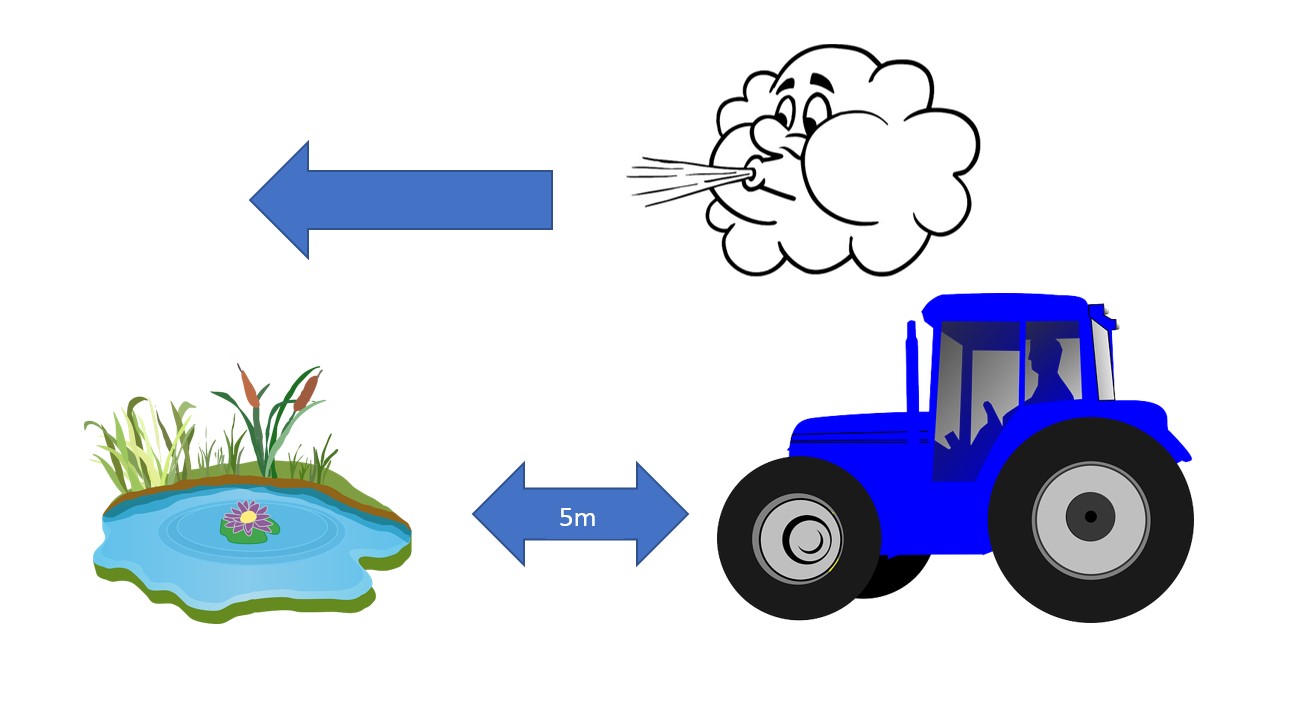Spray drift restraints and buffer zones
In 2019, the Australian Pesticides and Veterinary Medicines Authority (APVMA) published the Spray drift risk assessment manual.
This manual provides a risk assessment for all products to be assessed for the potential impact of spray drift caused by approved use patterns. If spray drift is considered to have an adverse impact, labels will specify mandatory buffer zones. The requirements are located on product labels before the Directions for Use table, under the headings of 'Spray drift restraints' and/or ‘Buffer zones'.
Buffer zones
Buffer zones have been introduced to protect sensitive areas from the effects of spray drift by imposing a separation between them and the location of spraying.
Buffer zones specify a distance down-wind (direction of the prevailing wind at the time of spraying) from a sensitive area that cannot be sprayed while the wind continues to blow in that direction. The distance is established according to the potential impact a product may have on one or more of the sensitive areas identified by the APVMA.
Not all products have a buffer zone and the buffer zone distances will vary. They will only be incorporated on a label when a sensitive area has been identified to be at risk. Some products will have a number of identified sensitive areas, while others may only have one or none.
Lower-drift equipment and methods
The APVMA recognises that some chemical users have already moved to lower-drift equipment and methods or are considering such improvements. As a result, the APVMA's Drift Reducing Technology (DRT) Incentives Program will support chemical users who adopt better technologies and risk management methods and will provide an incentive for others to do the same. The APVMA will issue DRT permits following the assessment of valid scientific information submitted to the APVMA which demonstrates that the technology is able to reduce spray drift, and therefore reduce the buffer zone distance. The permit will apply to those users who comply with the conditions of the permit.
Depending on the approved uses on a label, assessments will be made on different application methods including boom sprayers and/or orchard/vineyard sprayers, different crops or situations and equipment settings. As a result, labels may also include requirements for spray droplet sizes (for boom sprayers only), types of equipment, wind speed restrictions, boom heights, and other drift management methods.
APVMA identified sensitive areas
Sensitive areas identified by the APVMA include:
- Terrestrial vegetation: sensitive crops, gardens, landscaping vegetation, protected native vegetation/ animal habitat and non-target vegetation.
- Aquatic areas: aquaculture ponds, surface streams and rivers.
- Human health: people, structures that people occupy (residences, schools, day care, workplaces), parks and recreation areas.
- Trade: land that has food-producing animals, or any land that is producing feed for food-producing animals.
Key messages:
- Not all products will have mandatory buffer zones.
- Mandatory buffer zones will be different for different products, sensitive areas and application methods.
- Mandatory buffer zones are applicable ONLY when the sensitive area is downwind of the area being sprayed.
- Mandatory buffer zones only apply to the sensitive areas and application methods listed on the label.
- The Drift Reduction Technology (DRT) Incentives Program will allow for the opportunity of a reduction in buffer zone distances.
For full details of these changes please refer to the APVMA website.
When do buffer zone statements apply?
A product only has a mandatory downwind buffer zone of 20 m from sensitive aquatic areas when used with a COARSE droplet in a 3 to 20 km/hr wind. In which of these situations can I spray?
Example 1: spraying 25 m away from a sensitive aquatic area
Spraying is occurring 25 m away from a sensitive aquatic area. The wind is blowing towards the sensitive area. Can I spray?
YES. The buffer zone on this product is only 20 m from the sensitive aquatic area.

Example 2: spraying is occurring 5 m away from a sensitive aquatic area
Spraying is occurring 5 m away from a sensitive aquatic area. The wind is blowing away from the sensitive area. Can I spray?
YES. The 20m buffer zone only applies when the wind is blowing towards the sensitive aquatic area.

Example 3: spraying occurring 5 m away from a sensitive aquatic area
Spraying is occurring 5 m away from a sensitive aquatic area. The wind is blowing towards the sensitive area. Can I spray?
NO. The closest you can get to the sensitive aquatic area when the wind is blowing towards it when using this product is 20 m.

Example 4: spraying occurring 5 m away from a livestock area
Spraying is occurring 5 m away from a livestock area. The wind is blowing towards the livestock area. Can I spray?
YES. The 20m buffer zone only applies when the wind is blowing towards a sensitive aquatic area (food-producing animals are not identified as being sensitive to this product in terms of trade risk).

More resources
- Buffer zones and vegetative barriers — Buffer zones and vegetative barriers are valuable tools that can be used to reduce the potential for spray drift when applying agricultural chemicals.
- Living in harmony pesticides and bees — Information on managing risks associated with agricultural spraying near apiary sites.
- Recognising surface temperature inversions — It is unsafe to spray when conditions favour surface temperature inversions, due to the potential for spray drift. Learn how to identify weather conditions associated with surface temperature inversions.
- Visual Guide to estimating wind speed — This guide is not intended as a substitute for electronic hand held weather meters, which are available from spray equipment suppliers.
- Volatile vapour drift risk — Learn about the risks associated with volatile vapour production by ester formulations of phenoxy herbicides.